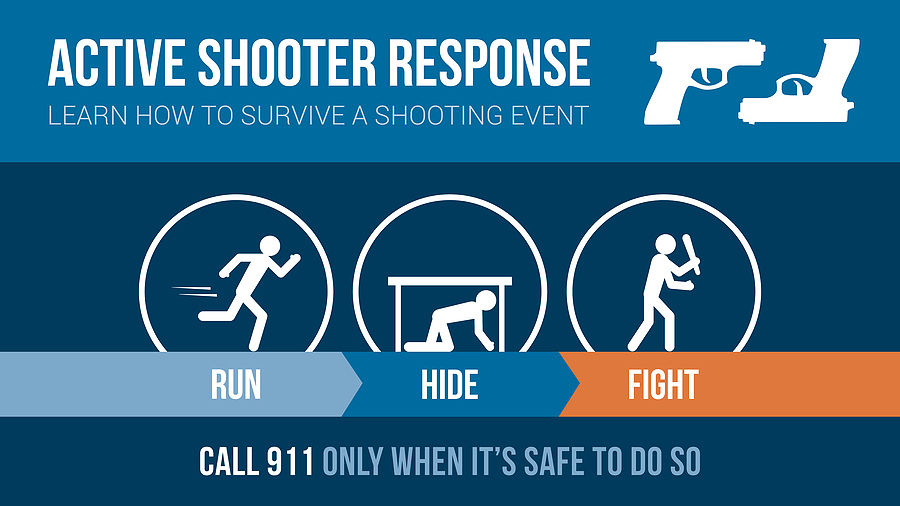What Should Be Included in an Effective Active Shooter Plan?

Workplace violence can manifest as any level of verbal abuse to fatality, and can involve any person at the workplace, be it employee, client, contractor or visitor.
Workplace violence is violence or the threat of violence against workers.
Whether the abuse is directed at them, or comes in some other form; employers have a responsibility to do whatever they can to shield their staff from abuse in the workplace. Here, we break down what active shooter training means for employers.
Workplace Violence is Increasing
Healthcare providers are at high risk for workplace violence. Two million American workers are assaulted in the workplace each year, and homicide is one of the top four causes of workplace deaths in the United States.
There have been more than 277 active shooter incidents over the last two decades, primarily at businesses, schools, government offices and other locations dominated by employers.
Employers should establish a prevention program to protect workers and to prevent workplace violence. That includes an all-of-the-above approach to protecting workers:
- Management and worker commitment to safety
- Comprehensive company policies indicating zero tolerance for violence
- Periodic evaluation of prevention programs
- Commitment to workplace culture change
Training is an essential element of any workplace violence prevention initiative as well. For both employees and management to be able to identify, report and prevent cases of violence, programs need to be effective and part of workplace culture.
Healthcare employers must offer training on workplace violence to say they care about employees, patients, or customers. Efficient training can make the difference between manhood and treachery and between life and death, and in health care that’s especially true.
Employers’ Responsibilities
It is the legal and moral responsibility of employers to provide a safe and secure working environment, including reasonable efforts to protect against, and prepare for, active shooter or other violent situations.
This duty includes the responsibility to give that employee job-specific active shooter recognition training as part of his or her compliance training. Specifically, employers are responsible for the following:
- Evaluating exposure to the public, third parties, and client and other customer contact, and the potential for an active shooter or other violent incident in the workplace.
- Establishing and implementing a well-rounded workplace violence prevention program including policies and procedures to identify and report threats of violence to appropriate personnel, or the proper authorities, for all levels of services and nonurgent/nonemergent situations.
- Offering all employees — including new employees during their compliance training — regular and recurring active shooter training.
- Tailor active shooter training to suit the workplace’s particular circumstances, such as size of building, number of employees, or type of work.
- Access to emergency communication for all workers, and training on the proper use.
- Conducting periodic drills and exercises to simulate workplace violence incidents and test the response capabilities of the workplace violence prevention program and staff trained to respond to an active shooter.
- Periodically reviewing and revising the workplace violence prevention program and active shooter training as necessary to ensure the information is current and effective.
Not fulfilling these duties could lead to legal and monetary exposure for the employer and risk for the employees. As such, employers should view active shooter training and workplace violence prevention as a serious matter and incorporate it into their routine compliance training programs.
Active Shooter Training for Employees
Active shooter training is a natural extension of employee compliance training in arming employees for the potential for violent encounters while on the job. This course educates workers about signs, strategies and response planning if an active shooter or other violent situation were to occur in the workplace.
The training should include:
- How to make a quick decision in a possibly harmful situation
- Know where the exits and safe hide-outs are located.
- Prepare for the self-protection and escape plan.
- How to message with others during active shooter incidents
- Via emergency forms of communication
- The need to stay hushed
Active shooter training emphasizes the value of situational awareness and critical thinking — such as interpreting suspicious behaviors and finding a means of escape. Workers will also be taught to differentiate gunshots from other sounds in a work environment, such as construction or equipment noises.
The aim of active shooter training is to train employees to have the skills and confidence to immediately react in the case of an emergency situation and to save lives.
Beyond preparing for an active shooter incident, employees can be taught skills to prevent and intervene in workplace violence with an active shooter prevention campaign to recognize warning signs and take action to prevent the warning signs from becoming a violent act.
Creating a Culture of Safety
Within healthcare, active shooter training is even more paramount as the possibility of a hostile encounter with a patient or family member also exists. Hospitals and health care institutions are able to select from a variety of training programs developed especially for their industry, as well as personal safety programs that remotely foci on safety hazards not typically covered in safety training.
Some training sessions will be complemented by tabletop exercises, drills or simulations to evaluate the preparedness of staff and to allow them to practice response mechanisms.
Most training courses also include strategies to prevent workplace violence as well as identifying and managing potential threats before they become reality.
Active Shooter Safety Planning
Following templates on how to write an active shooter safety plan are available online to help businesses and healthcare organizations create one for their own facilities, for example. These available resources include free guides and checklists, as well as full-on training courses and consulting services.
Step-by-step guidance for developing an active shooter safety plan, including identifying potential threats, making a plan, and practicing; as well as the role of employees in identifying and reporting potential threats is available on the Department of Homeland Security (DHS) Active Shooter Safety Plan Toolkit.
Other resources are online classes and webinars, as well as a forum where businesses and health facilities can hear from experts and swap best practices.
Active Shooter Training
The Active Shooter Training Albuquerque course developed by Safety Counselling is the course that no one wants to take, but people need to be ready.
There has been an increased media attention on active shooters and since there has been a sharp increase of shooting incidents, you need to learn how to handle a situation if an active shooter situation ever arises in your life. When you know what to do ahead of time, it can make a world of difference when you’re trying not to freak out and are challenged trying to figure out what it is you need to do to survive and keep yourself out of harm’s way.
What will be covered?
- What is an Active Shooter?
- Types of Active Shootings
- Historical Examples
- How to Prepare
- What to do when faced with an active shooter situation
- Law Enforcement Response
- Dispatch’s Role
- EMS Response
- Techniques to reduce escalating situations
- PTSD – Post Traumatic Stress Disorder
- CISD – Critical Incident Stress Debriefing
- EAP – Emergency Action Plan
CALL TO REGISTER – 505-881-1112
We pray that you will never experience an active shooter. However, you must be prepared when you are faced with one.
Training will make you more likely to survive and not be injured. Our Active Shooter Training under Safety Counselling, here in Albuquerque deliver you the information you will need to keep yourself safe, healthy and secure.
